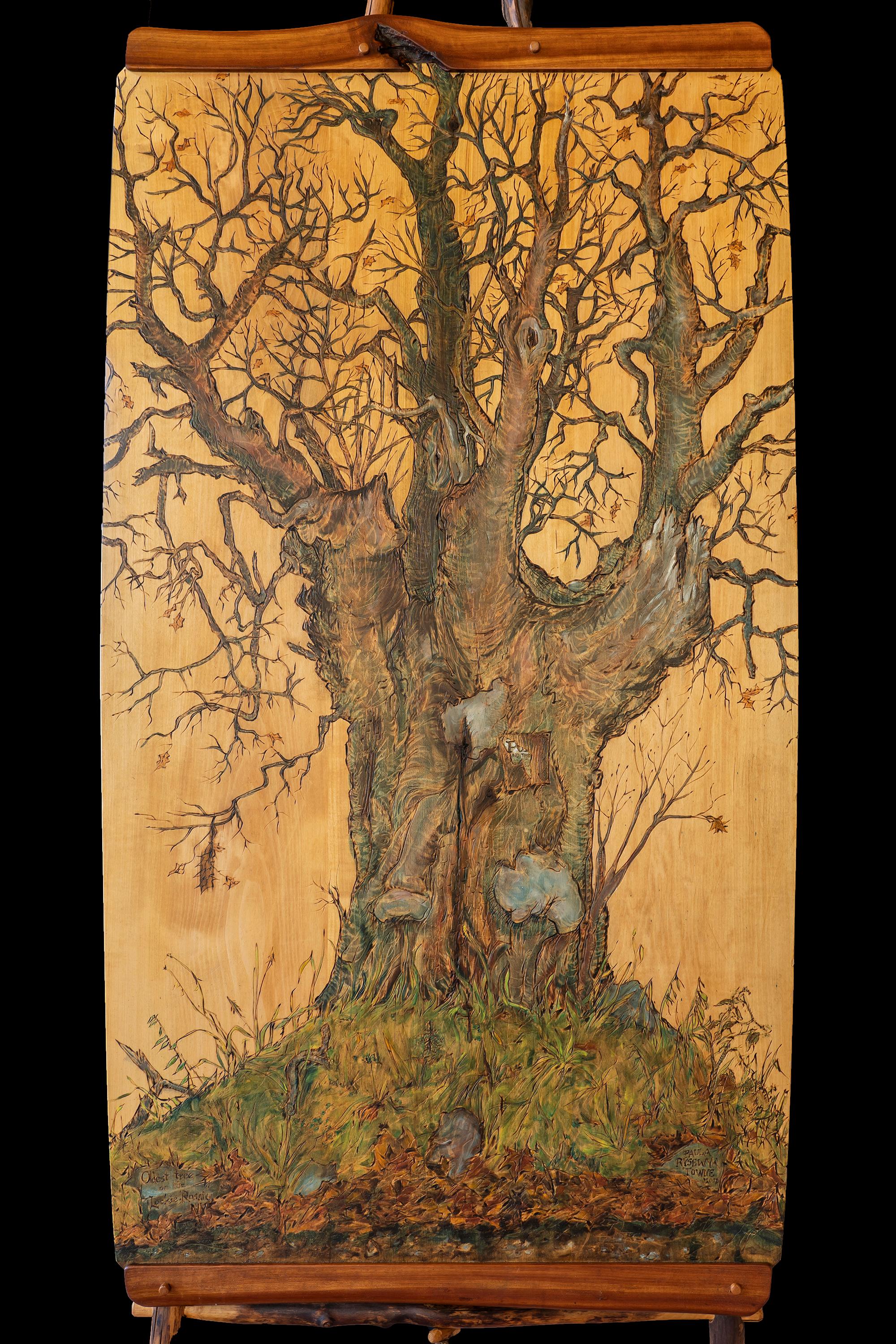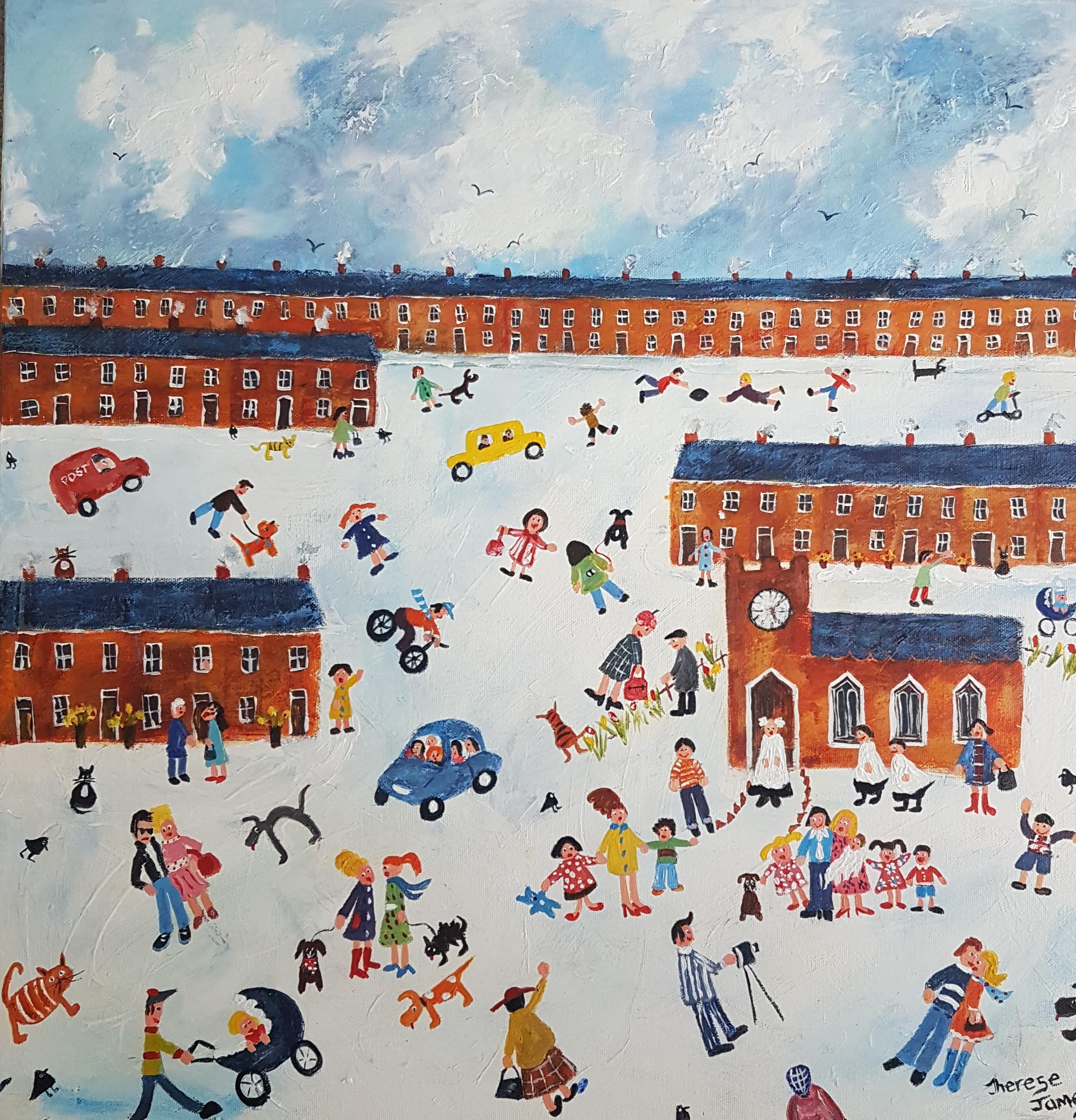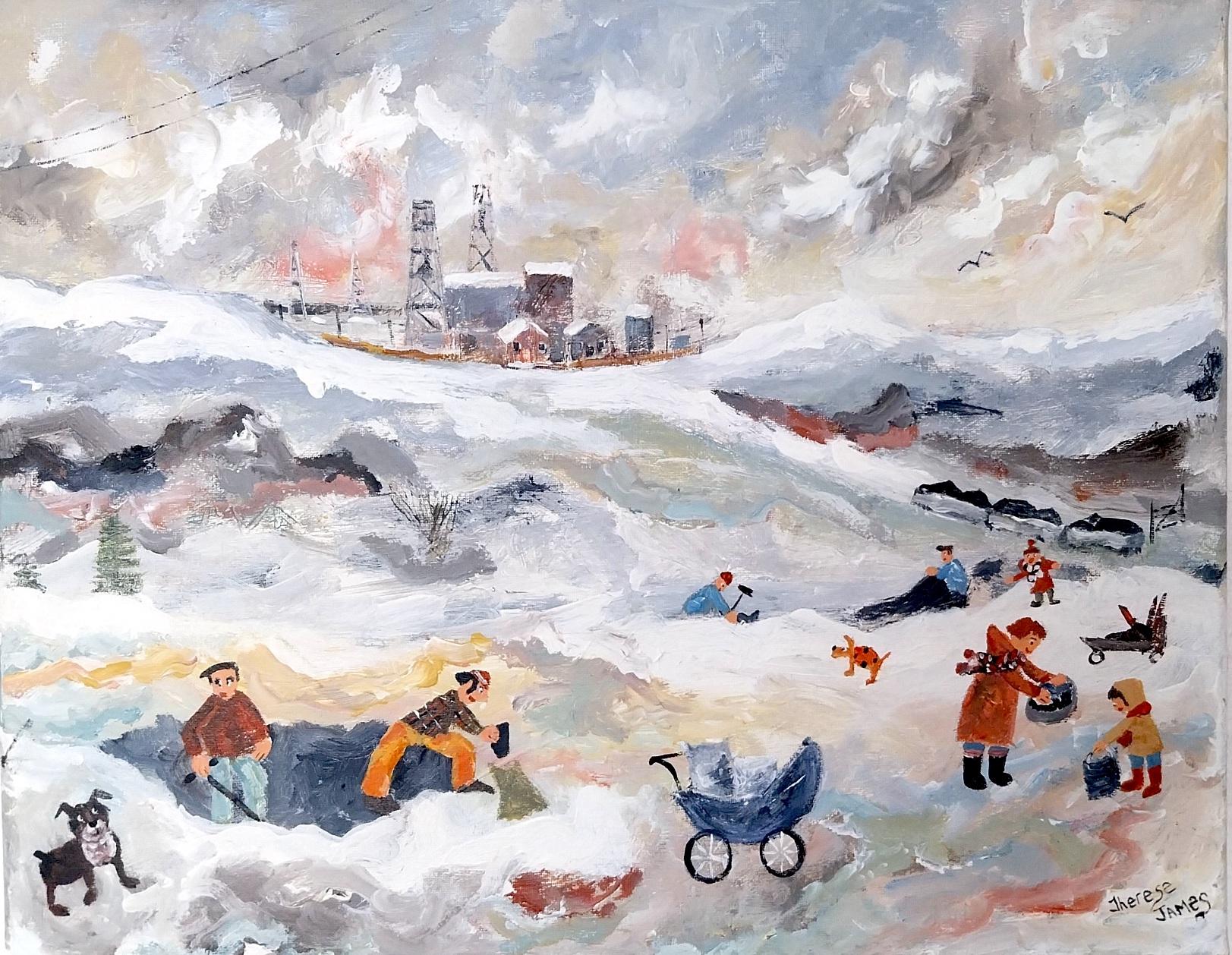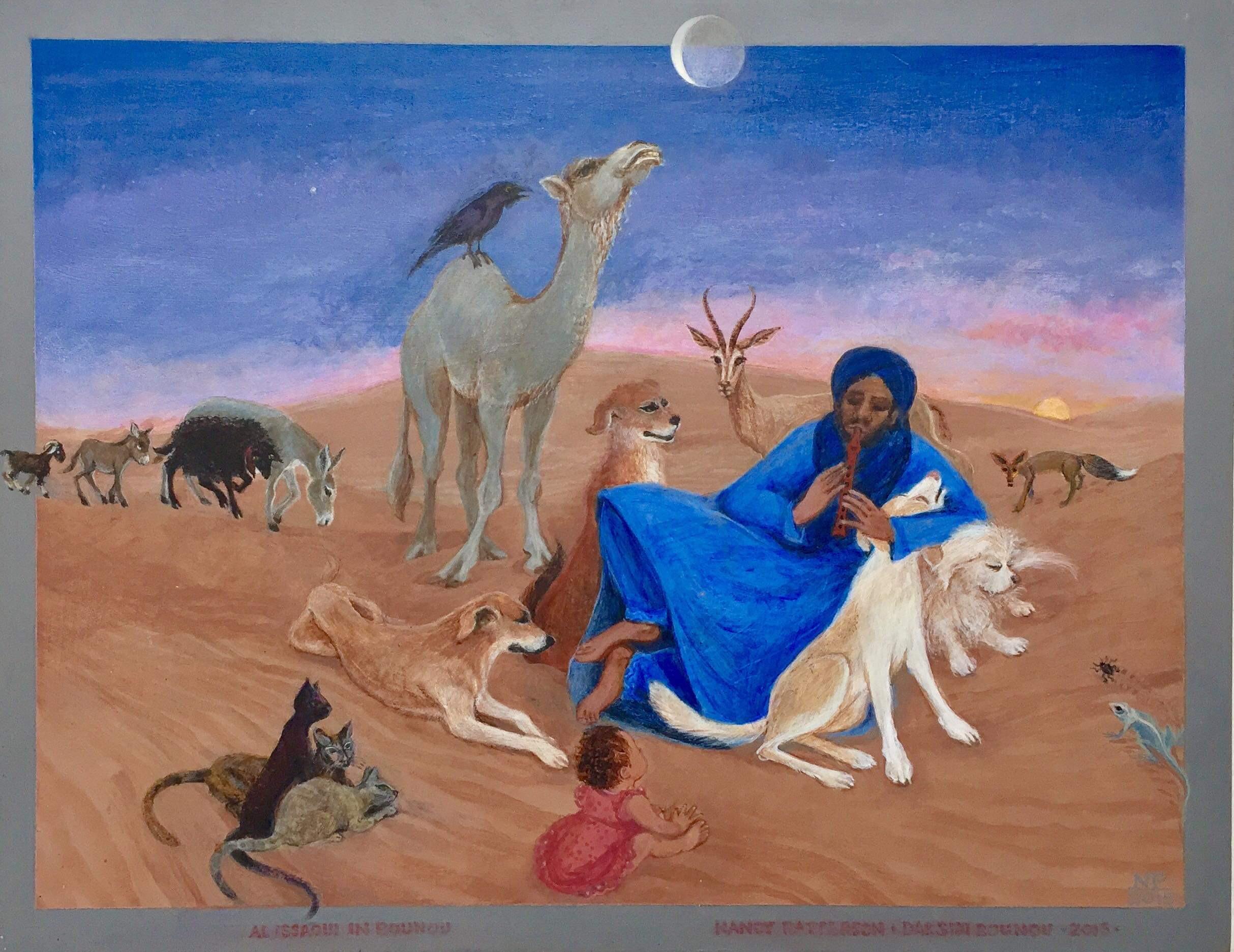Items Similar to Holy Rain & video, a vernacular folk painting by a self-taught African American
Want more images or videos?
Request additional images or videos from the seller
1 of 5
P-NutHoly Rain & video, a vernacular folk painting by a self-taught African American
About the Item
The multimedia work, "Holy Rain" includes a 1 1/2 minute Video of self-taught P-Nut talking about the inspiration for his folk painting of African Americans' catching rain water. "Holy Rain" depicts slaves outside at night catching the "holy" rain in their personal rain buckets. The rain comes from heaven; thus is holy. In the past, African Americans used the water to wash their clothes and for cooking. P-Nut’s remarkable archive of inherited stories and life experiences supply him with unlimited narratives telling stories of African heritage.
P-Nut’s powerful vernacular artwork ties to Gullah Geechee and Lowcountry culture. His work is crucial to preserving Southern African American history, as it communicates stories that would otherwise be untold. Almost half of our country’s African American citizens came through Charleston and today, nearly 80 percent of African Americans can potentially trace an ancestor who arrived in Charleston. P-Nut’s first artwork, a mixed-media collage, was done with the help of his mother, Albertha Johnson, when he was just nine years old. P-Nut often recounts how she instilled in him a passion for the arts, passed down a tradition of rich Gullah Geechee culture, and emphasized the importance of community.
The video will be published as soon as we make it smaller for the 1st Dibs website. The collector will receive the unedited video with sound. It can be viewed on YouTube by searching P-Nut Holy Rain.
- Creator:P-Nut
- Dimensions:Height: 36 in (91.44 cm)Width: 38 in (96.52 cm)
- Medium:Acrylic,Video
- Movement & Style:
- Period:
- Condition:
- Gallery Location:Charleston, US
- Reference Number:

About the Seller
5.0
Gold Seller
These expertly vetted sellers are highly rated and consistently exceed customer expectations.
Established in 2001
1stDibs seller since 2021
49 sales on 1stDibs
- ShippingRetrieving quote...Ships From: Charleston, US
- Return PolicyA return for this item may be initiated within 7 days of delivery.
More From This SellerView All
- Terrier Dog Proudly Splashing Through the Water with a Stick in His MouthLocated in Charleston, US"Rads with Stick" is a charming dog painting of a Terrier swimming along proudly holding his stick in the air. Kait Ballantyne's dog paintings often explore the interaction of Bord...Category
2010s Realist Animal Paintings
MaterialsAcrylic
- Vibrant Red Parrot Tulips Reach Up to The Sky in Dramatic Vertical Still-LifeBy Beth de LoiselleLocated in Charleston, USBeth de Loiselle's floral still-life oil painting, '"Parrot Tulips in the Sky," captivates viewers with vibrant colors and unique stylization. In Beth de Loiselle's composition, re...Category
2010s Realist Still-life Paintings
MaterialsOil
- Dog Painting of a Beautifully Feathered Golden Retriever a in Country LandscapeBy Beth CarlsonLocated in Charleston, US"Golden Pond" a charming dog painting by Beth Carlson of a beautiful Golden Retriever resting next to a pond in a country landscape. The painting combines her talent depicting dogs b...Category
21st Century and Contemporary Realist Animal Paintings
MaterialsOil
- Drama of the Sunset at the Brahma Temple in the Grand Canyon is Awe InspiringLocated in Charleston, USNancy Pellatt's "Last Glorious Light" is a western landscape that captures an awe inspired depiction of a Grand Canyon sunset at Brahma Temple, as seen from the North Rim of the Canyon. A California...Category
2010s Realist Landscape Paintings
MaterialsOil
- Foolish Jack Russell Terriers hunting for a Chipmunk in a Beautiful LandscapeBy Beth CarlsonLocated in Charleston, US"Chipmunk Hunters" another charming narrative by Beth Carlson of Jack Russell's hunting for a chipmunk in a beautiful country landscape. The Wirehair Jack Russell on the right is the...Category
2010s Realist Animal Paintings
MaterialsOil
- Carriage Horse Painting on a Romantic City Street on a Cold NightLocated in Charleston, USValarie Wolf's painting "Night Travel" is an excellent example of her charming narrative horse paintings. The way she portrays the misty breath of the carriage horse on a charming c...Category
2010s Realist Animal Paintings
MaterialsOil
You May Also Like
- Oldest Tree on the Lockie Road, Rossie New York, Acrylic on Wood by Paula TowneBy Paula TowneLocated in Long Island City, NYA unique painting and woodburning by self-taught American artist Paula Towne (1948-2019). Towne embraced the beauty of Northern New York where she lived and worked for over 50 years....Category
Early 2000s Outsider Art Landscape Paintings
MaterialsWood Panel, Acrylic
- Into God's Hands: Contemporary Figurative PaintingBy Therese JamesLocated in Brecon, PowysAcrylic paint on box canvas. Ready too hang SignedCategory
2010s Outsider Art Figurative Paintings
MaterialsAcrylic
- He Remembers His Days As A Young Man. Contemporary Figurative PaintingBy Therese JamesLocated in Brecon, PowysFrom an exhibition created by the artist to celebrate the UK Miners strike from the 1980's These hard times for whole communities in the Welsh Valleys created a sense of togetherness...Category
2010s Outsider Art Figurative Paintings
MaterialsAcrylic
- Digging Deep. Contemporary Naive School Figurative PaintingBy Therese JamesLocated in Brecon, PowysFrom an exhibition created by the artist to celebrate the UK Miners strike from the 1980's These hard times for whole communities in the Welsh Valleys created a sense of togetherness...Category
2010s Outsider Art Figurative Paintings
MaterialsAcrylic
- Magic Realist Surrealist Latin American Naive Fantasy PaintingBy German Ramon Duron LanzaLocated in Surfside, FLMagic realist fantasy painting in the manner of Ernst Fuchs and Arik Brauer. Naïve art is any form of visual art that is created by a person who lacks the formal education and training that a professional artist undergoes (in anatomy, art history, technique, perspective, ways of seeing). Unlike folk art, naïve art does not necessarily evince a distinct cultural context or tradition. Naïve art is recognized, and often imitated, for its childlike simplicity and frankness. Paintings of this kind typically have a flat rendering style with a rudimentary expression of perspective. One particularly influential painter of "naïve art" was Henri Rousseau (1844–1910), a French Post-Impressionist who was discovered by Pablo Picasso. Naïve art is often seen as outsider art that is by someone without formal (or little) training or degree. While this was true before the twentieth century, there are now academies for naïve art. Naïve art is now a fully recognized art genre, represented in art galleries worldwide. Museums devoted to naïve art now exist in Kecskemét, Hungary; Riga, Latvia; Jaen, Spain; Rio de Janeiro, Brasil; Vicq France and Paris. "Primitive art" is another term often applied to art by those without formal training, but is historically more often applied to work from certain cultures that have been judged socially or technologically "primitive" by Western academia, such as Native American, sub saharan African or Pacific Island art (see Tribal art). This is distinguished from the self-conscious, "primitive" inspired movement primitivism. Another term related to (but not completely synonymous with) naïve art is folk art. There also exist the terms "naïvism" and "primitivism" which are usually applied to professional painters working in the style of naïve art (like Paul Gauguin, Mikhail Larionov, Paul Klee). At all events, naive art can be regarded as having occupied an "official" position in the annals of twentieth-century art since - at the very latest - the publication of the Der Blaue Reiter, an almanac in 1912. Wassily Kandinsky and Franz Marc, who brought out the almanac, presented 6 reproductions of paintings by le Douanier' Rousseau (Henri Rousseau), comparing them with other pictorial examples. However, most experts agree that the year that naive art was "discovered" was 1885, when the painter Paul Signac became aware of the talents of Henri Rousseau and set about organizing exhibitions of his work in a number of prestigious galleries. The Earth Group (Grupa Zemlja) were Croatian artists, architects and intellectuals active in Zagreb from 1929 to 1935. The group included the painters Krsto Hegedušić, Edo Kovačević, Omer Mujadžić, Kamilo Ružička, Ivan Tabaković, and Oton Postružnik, the sculptors Antun Augustinčić, Frano Kršinić, and the architect Drago Ibler. A term applied to Yugoslav (Croatian) naive painters working in or around the village of Hlebine, near the Hungarian border, from about 1930. Some of the best known naive artists are Dragan Gaži, Ivan Generalić, Josip Generalić, Krsto Hegedušić, Mijo Kovačić, Ivan Lacković-Croata, Franjo Mraz, Ivan Večenaj and Mirko Virius. Camille Bombois (1883–1970) Ferdinand Cheval, known as 'le facteur Cheval' (1836–1924) Henry Darger (1892–1973) L. S. Lowry (1887–1976) Grandma Moses, Anna Mary Robertson (1860–1961) Nikifor (1895–1968) Poland, Horace Pippin (1888–1946) Jon Serl (1894-1993) United States Alfred Wallis (1855–1942) Scottie Wilson (1890–1972) Gesner Abelard (b. 1922) Jan Balet (1913–2009) Michel Delacroix (b. 1933) France Howard Finster (1916–2001) Ivan Rabuzin (1921–2008) Spontaneous Art Museum in Brussels Art en Marge Museum in Brussels MADmusée in Liege International Museum of Naive Art of Brazil in Cosme Velho, Rio de Janeiro Gallery Jacques Ardies in São Paulo Musée international d'art naïf de Magog in Magog Croatian Museum of Naïve Art in Zagreb Gallery of Croatian Naïve Art...Category
20th Century Folk Art Figurative Paintings
MaterialsCanvas, Acrylic
- Folk Art Painting, Female Canadian artist, Morocco Desert Blue Dogs Cats MoonBy Nancy PattersonLocated in Norfolk, GBThis evocative Folk Art painting on board is by the fabulous British Canadian artist Nancy Patterson. It comes from her series ‘Days in the Desert Sun,...Category
2010s Folk Art Figurative Paintings
MaterialsBoard, Acrylic





